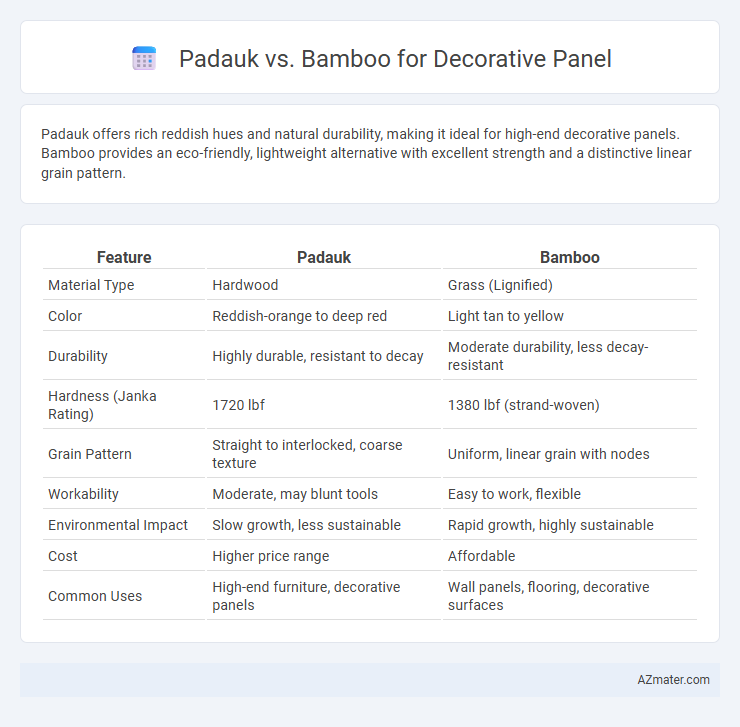Padauk offers rich reddish hues and natural durability, making it ideal for high-end decorative panels. Bamboo provides an eco-friendly, lightweight alternative with excellent strength and a distinctive linear grain pattern.
Table of Comparison
| Feature | Padauk | Bamboo |
|---|---|---|
| Material Type | Hardwood | Grass (Lignified) |
| Color | Reddish-orange to deep red | Light tan to yellow |
| Durability | Highly durable, resistant to decay | Moderate durability, less decay-resistant |
| Hardness (Janka Rating) | 1720 lbf | 1380 lbf (strand-woven) |
| Grain Pattern | Straight to interlocked, coarse texture | Uniform, linear grain with nodes |
| Workability | Moderate, may blunt tools | Easy to work, flexible |
| Environmental Impact | Slow growth, less sustainable | Rapid growth, highly sustainable |
| Cost | Higher price range | Affordable |
| Common Uses | High-end furniture, decorative panels | Wall panels, flooring, decorative surfaces |
Introduction to Padauk and Bamboo Decorative Panels
Padauk decorative panels, crafted from the vibrant reddish-orange wood of the Pterocarpus genus, offer exceptional durability and a striking aesthetic with natural grain patterns that enhance interior spaces. Bamboo panels, made from fast-growing grass species, provide a sustainable and lightweight alternative featuring a warm, natural texture and remarkable resilience against moisture and pests. Both materials excel in eco-friendly applications, with Padauk prized for its rich color and Bamboo valued for its renewable properties and sleek, modern appearance.
Aesthetic Appeal: Padauk vs Bamboo
Padauk offers a rich, vibrant reddish-orange hue with a fine, straight grain that provides a luxurious and striking aesthetic for decorative panels. Bamboo features a light, natural color with a smooth texture and subtle linear grain pattern, lending a minimalist and contemporary look ideal for modern interiors. The choice between Padauk and Bamboo depends on whether the design prioritizes bold warmth or a clean, airy feel.
Durability and Strength Comparison
Padauk offers exceptional durability and strength, making it ideal for decorative panels that require long-lasting performance and resistance to wear. Its dense grain structure provides superior hardness compared to bamboo, which, while strong, is generally more flexible and less impact-resistant. Bamboo panels are lightweight and sustainable but do not match Padauk's robustness and resistance to dents or scratches in high-traffic or heavy-use environments.
Sustainability and Environmental Impact
Padauk wood, known for its vibrant reddish hue and durability, is often harvested from tropical forests where unsustainable logging can threaten biodiversity, making its environmental impact a concern unless sourced from certified plantations. Bamboo, a rapidly renewable grass, grows quickly without the need for pesticides or fertilizers, sequesters carbon efficiently, and regenerates after harvesting without replanting, positioning it as a highly sustainable option for decorative panels. Choosing bamboo over Padauk significantly reduces deforestation risk and promotes eco-friendly building practices due to its superior renewability and lower carbon footprint.
Cost and Availability Analysis
Padauk wood generally commands a higher price than bamboo due to its dense grain, durability, and rarity, making it a premium choice for decorative panels. Bamboo, being a fast-growing and renewable resource, offers a more cost-effective and widely available option, especially in regions with vibrant bamboo industries. Availability of Padauk is often limited to specialty suppliers or imports, whereas bamboo panels can be sourced locally in many parts of the world, enhancing supply chain efficiency.
Installation Process and Ease
Padauk wood offers a smooth installation process due to its stable grain and moderate hardness, allowing for easy cutting, nailing, and sanding during decorative panel applications. Bamboo panels, being lighter and more flexible, simplify handling and mounting but may require additional attention to prevent splitting and ensure secure fastening. Both materials support efficient installation, with Padauk favoring precision and durability, while Bamboo emphasizes lightweight convenience.
Maintenance and Longevity
Padauk offers superior durability and resistance to wear, making it a low-maintenance choice for decorative panels, as it naturally resists decay and insect damage. Bamboo, while eco-friendly and cost-effective, requires regular sealing and treatment to prevent moisture damage and prolong its lifespan in decorative applications. Both materials benefit from protective finishes, but Padauk's inherent robustness ensures longer-lasting beauty with less frequent maintenance.
Design Versatility and Applications
Padauk offers rich reddish hues and fine grain patterns that enhance design versatility for decorative panels, making it ideal for high-end interior applications like cabinetry and feature walls. Bamboo provides a lighter color palette with uniform texture and superior sustainability, suited for modern, eco-friendly spaces including office partitions and ceiling panels. The natural durability of Padauk supports intricate carvings, while bamboo's flexibility allows for curved and modular designs, expanding their respective application possibilities.
Consumer Preferences and Trends
Padauk wood is favored for decorative panels due to its rich reddish-orange hue and durability, appealing to consumers seeking vibrant, long-lasting materials. Bamboo gains popularity for its sustainability, lightweight nature, and natural grain patterns, aligning with eco-conscious trends in interior design. Growing consumer preference leans toward bamboo for modern, minimalist aesthetics, while Padauk remains a choice for traditional and luxurious finishes.
Conclusion: Choosing the Right Material
Padauk offers rich reddish hues and exceptional durability, making it ideal for high-end decorative panels that require longevity and vibrant aesthetics. Bamboo provides a sustainable, lightweight, and cost-effective alternative with unique grain patterns suited for eco-friendly and modern design preferences. Selecting between Padauk and Bamboo ultimately depends on budget, design goals, and environmental considerations, balancing luxury appeal against sustainability priorities.

Infographic: Padauk vs Bamboo for Decorative Panel
 azmater.com
azmater.com